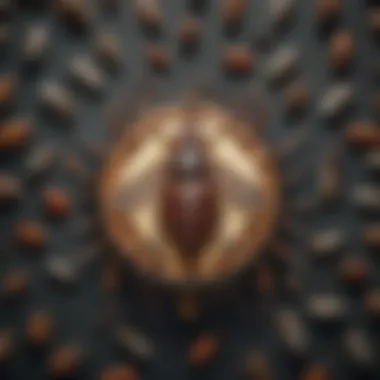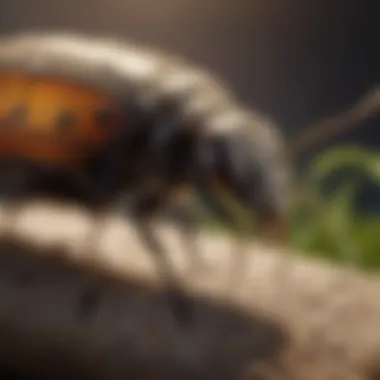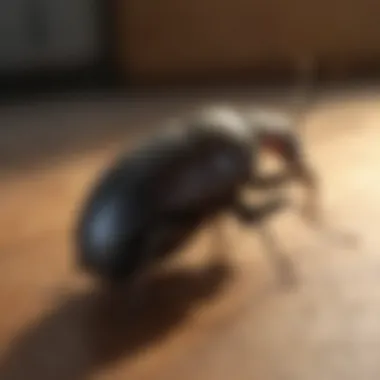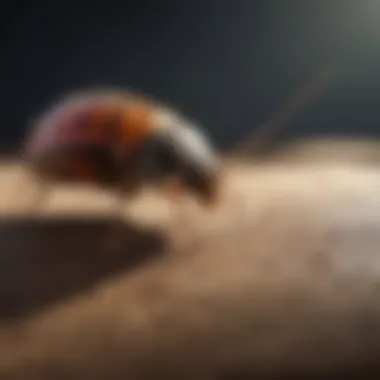Comprehensive Guide to Pest Services: Bugs A to Z


Intro
Pest control is a topic of vital importance for homeowners. Understanding the different types of pests that can invade a living space is the first step for effective prevention and management. This guide aims to assist readers in recognizing these pests, implementing preventive measures, and exploring treatment options. By providing detailed insights—from identification to treatment solutions—homeowners can take charge of their pest-related concerns successfully.
Pest Identification
Identifying pests accurately is crucial. Each type of pest presents unique characteristics, behaviors, and risks that necessitate different approaches for control. Below are some detailed descriptions of common pests:
Detailed Descriptions of Common Pests
- Ants: These small insects are often found in kitchens and gardens. They may form trails as they search for food. Carpenter ants can damage wooden structures when they create nests inside.
- Cockroaches: Known for their resilience, cockroaches often inhabit dark and humid areas. Their presence can indicate poor sanitation and can lead to health issues.
- Rodents: Mice and rats are not only nuisances but can also cause structural damage and transmit diseases. They often leave droppings and gnaw marks behind.
- Termites: These wood-destroying insects can cause significant damage to structures. They usually remain hidden, making early detection difficult.
- Bed Bugs: Small, nocturnal insects that feed on human blood. Signs of their presence include bite marks and rusty stains on bedding.
Signs and Symptoms of Infestations
Detecting pests early can prevent larger issues. Here are common signs to watch for:
- Unusual Sounds: Noises from walls or under floors can indicate rodent activity.
- Droppings: Finding droppings in your home often suggests a pest problem.
- Nesting Materials: Clusters of shredded paper or fabric may signal mice or rats.
- Damage: Torn fabrics, chewed food packaging, or unexplained holes in the walls are often clear indicators of pest activity.
"Regular inspections and early detection can save you time, money, and stress later."
Prevention Strategies
Preventing pests from entering your home is more effective than dealing with an infestation. Here are several strategies to keep pests at bay:
Home Maintenance Tips for Pest Prevention
- Seal Entry Points: Check windows, doors, and cracks in the walls to minimize entry possibilities.
- Manage Outdoor Areas: Keep gardens tidy and remove debris. Overgrown vegetation can attract pests.
- Proper Food Storage: Store food in airtight containers to avoid attracting insects and rodents.
Natural Deterrents and Barriers
Using natural remedies can be an effective way to deter pests:
- Essential Oils: Some oils like peppermint and eucalyptus can repel insects and rodents.
- Diatomaceous Earth: This natural powder can be sprinkled in areas where pests are seen, creating a barrier.
Treatment Options
If prevention measures do not suffice, understanding treatment options becomes essential. There are various methods for dealing with pests effectively.
Overview of Chemical vs. Natural Treatments
- Chemical Treatments: These include insecticides and rodenticides, which can be effective but should be used cautiously, especially around children and pets.
- Natural Treatments: These involve using non-toxic solutions and can include homemade options such as vinegar sprays.
Step-by-Step Guides for DIY Treatments
For those who prefer a hands-on approach, here are basic guidelines for DIY treatments relating to common pests:
- For Ants: Mix equal parts of vinegar and water and spray areas where they are seen.
- For Cockroaches: Use a combination of baking soda and sugar; the sugar attracts them, while the baking soda is lethal.
- For Rodents: Set up snap traps along walls in areas where signs of activity are noticed.
Understanding these aspects of pest services equips homeowners with tools and knowledge necessary for effective pest management. This comprehensive guide is designed to serve as a valued resource as readers navigate the complexities associated with pest control.
Prelude to Pest Management
Pest management is a critical component of maintaining a healthy and safe living environment. Understanding pests and the strategies for controlling them can significantly affect the well-being of households. This section introduces key aspects of pest management that will be explored further in the guide.
Definition of Pest Control
Pest control refers to the measures taken to manage, prevent, and eliminate pests that can cause harm to human health, property, and the environment. It encompasses a wide range of activities, from basic preventative techniques to professional extermination services. Pest control is not solely focused on lethality; rather, it incorporates integrated pest management (IPM) principles, which emphasize understanding the pest's life cycle, habitat, and behavior. This holistic approach ensures more effective and sustainable pest management solutions.
Importance of Understanding Pests


Understanding pests is essential for effective pest control. Awareness of pest species, their habits, lifecycle, and potential risks allows homeowners to take proactive measures. Here are some key reasons for this knowledge:
- Health Risks: Many pests carry diseases or allergens that can adversely affect household members.
- Property Damage: Certain pests, like termites, can cause significant damage to the structure of a home.
- Effective Control: Knowing the specific pest involved helps in choosing the right control method.
Understanding these aspects of pest control empowers homeowners to make informed decisions. It reduces reliance on chemicals and promotes safer, environmentally friendly pest management techniques. In the next sections, we'll delve deeper into the specifics of common pests and the best strategies for managing them.
"Knowing your enemy is half the battle." - Ancient Proverb
A to Z of Common Pests
The exploration of the A to Z of common pests is a foundational theme of pest management. Understanding various pests is essential for homeowners. It helps in identifying and effectively managing infestations. Each pest has distinct behaviors and characteristics that require tailored approaches for control. Recognizing these pests is often the first step in mitigating their impact on homes and well-being.
A broad knowledge of pests increases the chances of early detection and intervention, potentially saving time and money. These infestations can lead to structural damage, health issues, and a decline in property value if ignored. Highlighting the significance of this section helps readers appreciate the complexity and severity of pest problems, acting as a guide toward prevention and treatment options.
Ants
Ants are among the most common household pests. They typically enter homes in search of food. Certain species like the carpenter ant can cause serious structural damage. They dig through wood to create nests, weakening the integrity of beams or floors.
To manage ants effectively,
- Identify the species present.
- Monitor their movements.
- Use appropriate bait or barrier methods. This increases the likelihood of successful elimination.
Bed Bugs
Bed bugs, though small, pose significant concerns for householders. They feed on human blood and can cause discomfort through itching and irritation. Infestations often start in places like hotels or second-hand furniture. Once established in a home, they spread rapidly.
The identification of bed bugs is crucial. Look closely at mattresses and box springs for tiny rust-colored spots or shed skins. Treatments may include heat treatments, chemical sprays, or encasements that trap bed bugs within mattresses.
Cockroaches
Cockroaches are resilient pests that thrive in warm, dark, and moist environments. Common types include the German roach and American roach. These insects can contaminate food and surfaces with their droppings, leading to health risks.
Effective control strategies involve improving cleanliness, sealing entry points, and using various traps or insecticides. It is also important to identify sources of moisture as cockroaches are attracted to dampness.
Termites
Termites are silent destroyers. They can cause severe damage to wooden structures if left unchecked. The two main types are subterranean and drywood termites.
Preventive measures include:
- Regular inspections
- Removing sources of wood-to-soil contact
- Using barriers
If an infestation is suspected, it’s crucial to contact a pest control professional. Early treatment can significantly reduce repair costs.
Wasps
Wasps are often perceived as aggressive pests, especially during late summer when food becomes scarce. Unlike bees, wasps can sting multiple times, making them dangerous when defending their nests.
Management of wasps includes:
- Identifying nests early, usually located in eaves or trees.
- Avoiding direct confrontation. Instead, use traps or consult professionals for removal. Safe handling is key to preventing injuries.
Understanding the nuances of these pests allows for better preparation and response strategies to pest problems. This knowledge is a critical element for any homeowner aiming to maintain a safe and healthy living environment.
Identifying Pests
Identifying pests is a crucial aspect of effective pest management. It is not enough to know that a pest exists in your home or garden; understanding its characteristics and habits can drastically influence the control methods you choose. Proper identification helps in choosing the appropriate treatment, either through natural remedies or chemical options, aiming for effective and safe outcomes. Different pests require different approaches, making identification the first step towards resolution.
Physical Characteristics
Physical characteristics of a pest provide essential clues for identification. This includes size, color, body shape, and specific features such as wings or antennae. For example, the common house ant generally measures between 1/16 to 1/2 inch in size and exhibits a brown or black hue. In contrast, a bed bug can be identified by its flat, oval body which is brown and about the size of an apple seed. Recognizing these traits enables quick identification and helps homeowners determine the most suitable approach for pest control.


A few key physical characteristics to look for include:
- Size: Small or large, each type of pest has a typical range that can help in identification.
- Color: Color can vary widely across different pests, ranging from earthy tones to bright colors.
- Body Shape: Some pests have distinct shapes; for example, cockroaches have a lengthy, flat body.
- Wings: The presence or absence of wings can indicate specific insect types.
"Identifying pests accurately sets the stage for choosing the right management strategies, ensuring effectiveness and minimizing harm to the environment."
Behavioral Patterns
Beyond physical characteristics, understanding behavioral patterns also plays a vital role in pest identification. Different pests display unique behavior that is essential for their identification. For example, termites tend to be more active during specific times of the year and often exhibit swarming behavior, especially when mating. Knowing when pests are most active can help in determining potential infestations.
Some behavioral aspects to observe include:
- Feeding Habits: Many pests have specific diets. For example, mice may gnaw on a range of foods, while cockroaches prefer starches and sugars.
- Activity Levels: Certain pests are nocturnal (e.g., rats, bed bugs), while others may be active during daylight hours.
- Nesting Behavior: Observing where pests create nests or hives can indicate not only the type of pest but also potential points of entry into a home.
Recognizing both the physical and behavioral traits of pests can strengthen preventative measures and management strategies. It equips homeowners with the necessary insights to tackle pest-related issues effectively.
Preventive Measures in Pest Control
Preventive measures play a fundamental role in pest control by reducing the likelihood of infestations before they become significant problems. By proactively identifying potential risks and taking necessary actions, homeowners can save time, energy, and money while maintaining a healthy living environment. This section will explore essential strategies for preventing pests, emphasizing that foresight is key in effective pest management.
Home Maintenance Tips
A well-maintained home is less attractive to pests. Regular upkeep is crucial in preventing many pest issues. Here are several home maintenance tips:
- Seal Entry Points: Inspect windows, doors, and foundations for cracks and gaps. Seal any openings to eliminate routes for pests.
- Routine Cleaning: Maintain cleanliness, particularly in kitchens and dining areas. Regularly clean crumbs and spills.
- Proper Storage: Store food in airtight containers. This reduces food sources available to pests, including ants and cockroaches.
- Manage Waste: Dispose of trash regularly, and utilize bins with secure lids to prevent rodent attraction.
- Inspect for Leaks: Address plumbing leaks promptly. Moist environments encourage pest populations, especially for termites and some types of ants.
By following these maintenance tips, homeowners can significantly lower their chances of inviting unwanted guests.
Environment Adjustments
Adjusting the environment around the home is equally important in pest prevention. Simple modifications can deter pests from taking residence. Consider these adjustments:
- Landscaping: Keep plants well-trimmed, and avoid dense shrubbery against house walls. This prevents pests like rodents from nesting nearby.
- Remove Standing Water: Eliminate pools of stagnant water in gardens or on patios. Many pests, including mosquitoes, breed in these areas.
- Strategic Mulching: Use gravel or rocks instead of mulch near the foundation. Organic mulch can attract pests and hold moisture.
- Lighting Choices: Use yellow or sodium vapor lights outdoors. These are less attractive to insects than bright white lights.
"Proper home maintenance and environmental adjustments serve as the first line of defense against pervasive pests."
In summary, taking preventive measures through home maintenance and environmental adjustments significantly enhances pest control efforts. By being vigilant and mindful of surroundings, homeowners can effectively minimize the presence of pests and contribute to a healthier and more enjoyable living space.
Chemical vs. Natural Treatments
When selecting pest control methods, understanding the distinction between chemical and natural treatments is essential. This knowledge helps homeowners, particularly those who prefer to mitigate pest issues without adverse effects on health or the environment. Each method has its merits, and the right choice often depends on the specific pest problem, location, and the individual’s comfort level with pesticides.
Overview of Chemical Pest Control
Chemical pest control employs synthetic substances to eliminate pests effectively. These chemicals often target a wide array of pests, including insects, rodents, and other vermin. Common formulations include insecticides, fungicides, and rodenticides. This treatment type usually provides quick results
Some notable points about chemical pest control:
- Efficiency: Many chemical pesticides are designed for rapid action. This means they can significantly reduce pest populations in a short time.
- Target Specificity: Certain chemicals can be selective for specific types of pests, minimizing damage to beneficial organisms.
- Wide Availability: Chemical products are readily available in most hardware stores and online.
While there are strong advantages, it is important to consider the potential risks. Chemical treatment may lead to:
- Health Risks: Exposure to certain pesticides can produce acute and chronic health effects on humans and pets.
- Environmental Impact: Some chemicals may leach into soil and water systems, affecting non-target species and ecosystems.
- Resistance Development: Pests can develop resistance to commonly used chemicals, leading to more severe infestations over time.
Benefits of Natural Solutions
Natural pest control methods utilize substances derived from natural sources, often promoting a sense of safety for homeowners concerned with health and environmental effects. Here are some advantages of selecting natural solutions:
- Eco-Friendly: Natural treatments are typically biodegradable and less harmful to wildlife. They contribute to sustainable pest management practices.
- Safety: Organic options, such as diatomaceous earth or neem oil, tend to present significantly lower risks to pets and humans.
- Minimal Residue: Many natural products do not leave residual chemicals that can linger in the home or surrounding environment.
Natural pest control options include:


- Essential Oils: Products like peppermint or tea tree oil can repel certain pests without harming health.
- Trap Systems: Using traps for rodents and insects is an effective natural method that avoids the need for toxic baits.
- Cultural Practices: Adjustments like proper sanitation and modifications of landscaping can act as natural deterrents.
It is valuable to note, however, that natural solutions may not work as swiftly as chemical treatments. They often require repeated applications and an understanding of the specific pest behavior to be effective.
Common Myths in Pest Control
Understanding common myths in pest control is essential for effective management. Many homeowners harbor incorrect beliefs about pests and pest control strategies that could lead to ineffective treatments or unnecessary panic. While some myths may seem harmless, they can result in escalating infestations or increased expenses. By debunking these misconceptions, homeowners can make informed decisions that lead to better pest management outcomes.
Debunking Popular Beliefs
- Myth: All insects are harmful.
Many people believe that all insects pose a threat to their homes or health. In reality, many bugs are beneficial, helping with pollination or pest control. For instance, ladybugs feed on aphids, which can help keep gardens healthy. - Myth: Pest control only involves chemicals.
This is a widely held belief, but it is not accurate. While chemical treatments are an option, many natural solutions exist. Homeowners can utilize options like diatomaceous earth or essential oils, allowing for a more environmentally friendly approach. - Myth: If I don’t see pests, I don’t have a problem.
Many pests, such as termites, operate silently behind walls. A lack of visible pests does not mean the absence of a problem. Regular inspections are crucial to understand the status of any potential issues. - Myth: DIY methods are always effective.
While some DIY methods can be helpful for minor pest issues, they may not work for larger infestations. Professional services often provide tailored solutions based on specific types of pests and infestation levels.
Educating Homeowners
Education is a critical part of pest control. Many homeowners are unaware of their role in pest prevention and management. By providing clear information about pest behavior, effective prevention tactics, and treatment options, homeowners can significantly improve their pest management strategies.
- Recognize pest indicators. Knowing what signs to look for, like droppings or nests, can help in early detection.
- Learn about pest habitats. Understanding where pests thrive can lead to better home maintenance and prevention strategies.
- Stay informed about local pests. Each region has unique pest issues affected by climate and geography. Homeowners should educate themselves on local infestations and their solutions.
"Education leads to empowerment. Knowing the truth about pests equips homeowners to tackle infestations effectively."
Professional Pest Control Services
Professional pest control services play a significant role in ensuring a pest-free environment at home and work. These services are not merely about eliminating existing pests but also about implementing measures to prevent future infestations. Understanding the importance of professional assistance can make a notable difference in managing pest-related issues.
There are several reasons why homeowners might consider hiring a professional pest control service. Firstly, professionals have the expertise and training to identify the exact type of pest, which is critical in effective pest management. Many pests share similar physical characteristics, making identification difficult for the untrained eye. Professionals bring experience in understanding pest biology and behavior, enhancing their ability to develop targeted treatment solutions.
Secondly, professional pest control services utilize a broader range of treatment options compared to over-the-counter products. They have access to scientifically tested and formulated products that are often not available to the general public. This access ensures more effective solutions tailored to specific infestations.
Moreover, hiring professionals can save time and reduce stress. The process of trying to eliminate pests can be labor-intensive and frustrating. By entrusting these tasks to experts, homeowners can focus on other responsibilities, knowing that the pest situation is being handled competently. With these benefits in mind, it becomes clear that employing professional pest control services is not only a matter of convenience but also a sound investment in home safety and comfort.
"The use of a professional pest control service can provide peace of mind. It ensures that pest infestations are managed effectively and efficiently."
When to Hire a Professional
Knowing when to hire a professional pest control service can be just as crucial as the selection itself. Homeowners should consider seeking professional help in several scenarios. If you notice signs of a significant infestation—like droppings, nests, or structural damage—it is often best to call for professional assistance.
In addition, if DIY methods have been tried but have failed to provide effective results, it may signal that professional intervention is necessary. Certain pests, such as termites or bed bugs, can proliferate rapidly, making timely action essential to mitigate further damage. If allergies or health concerns are present, a professional can provide safer treatment options that minimize risks.
Choosing a Pest Control Company
Choosing a pest control company requires careful consideration. It is advisable to start by researching companies with a good reputation in the local community. Homeowners should look for companies that are licensed and insured, as this indicates adherence to industry standards. Checking for customer reviews and testimonials can offer insights into the quality of service provided.
Moreover, it is important to inquire about the methods used by the pest control company. A reputable company should be willing to explain their treatment plans, including any chemicals used and safety measures taken.
When evaluating potential companies, consider those that offer a thorough inspection before providing estimates. This ensures that the treatment plan is tailored to the specific needs of your situation.
Ultimately, finding the right pest control service can make a significant impact on the effectiveness of pest management in your home. The investment in professional services can lead to long-term peace of mind and a healthier living environment.
Culmination
In this comprehensive guide, we have unpacked various aspects of pest control services. Understanding the significance of effective pest management is vital for homeowners today. The insights provided equip you with the tools necessary to identify pests and initiate appropriate preventive measures. Each section has shed light on fundamental concepts that create a robust knowledge base for both novice and seasoned individuals in pest control.
Recapping Key Points
- Identification: Recognizing pests is the first step in effective management. The article detailed common pests like ants, bed bugs, and cockroaches, emphasizing their distinguishing features.
- Prevention: Home maintenance tips play a crucial role in prevention. Simple steps, such as sealing entry points and maintaining cleanliness, can significantly reduce pest attractions.
- Treatment Options: An informed choice between chemical and natural pest control methods was outlined, allowing readers to make decisions based on context and necessity. Organic solutions offer a safe alternative, while chemicals can provide immediate results in serious infestations.
- Myths Debunked: Understanding common myths in pest control allows homeowners to avoid ineffective solutions that waste time and resources.
- Professional Services: Guidelines were provided on when to consider hiring professionals and how to choose a reputable pest control company effectively.
Encouragement for Proactive Pest Management
Being proactive in pest management can save time, money, and unnecessary stress. It is important for homeowners to constantly assess their surroundings and take immediate action upon noticing any signs of pests. Regular inspections, even when no pests are visible, can often catch infestations before they escalate.
Consider keeping a log of any pest sightings, and schedule seasonal maintenance checks that focus on both the inside and outside of your home. Utilize barriers like screens and proper drainage to fend off possible infestations before they start.
Furthermore, education plays a powerful role. The more you learn about pests, the better prepared you will be to handle potential issues.
Proactive pest management fosters a healthier living environment and maintains the integrity of your home. Your home is worth the effort.
"Proactive management is not just about addressing problems as they arise but preventing them altogether."



